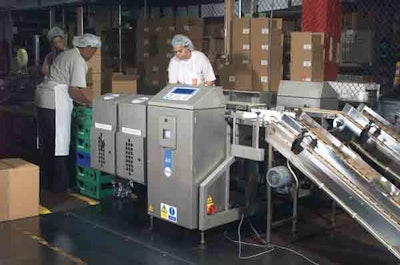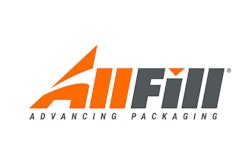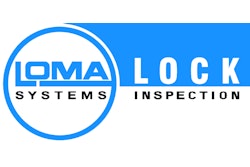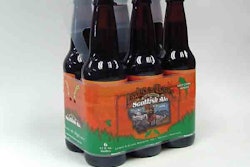A steady surge in demand for its portion-packed coffees left Coffee Bean International of Portland, OR, with no choice but to invest in new packaging equipment. Installed January of 2006, the new line includes a servo-driven, twin tube, intermittent-motion bag maker from Sandiacre (www.sandiacre.com) sitting beneath a pair of BSV600 servo-driven auger fillers from All-Fill (www.all-fill.com). And downstream, a Loma Systems (www.loma.com) AS checkweigher with serial link feedback automatically tells the auger filler to increase or decrease the fill based on averages of the ongoing weight samples that are measured.
“Operators enter the target weights into the Loma checkweigher and it communicates the proper weight to the filler. The checkweigher kicks out everything that is above and below those weight parameters,” says Robert Reed, vice president of manufacturing supply chain at CBI. “It also signals the auger to adjust.”
When you pack about eight million coffee portion packs annually, in sizes ranging from 1.5 to 12 oz., making sure that fill rates are accurate and product giveaway minimized is especially important. Reed figures that in the first eight months his firm had the new machinery in place and operating, he saved about $25,000 thanks to the checkweigher’s diligence. The checkweighers replaced a labor-intensive method of manually testing packs three to five times per hour.
“Sometimes we would test low, so that meant we would have to open the packages, scrap the material, and adjust the filler,” Reed says. “We sometimes ended up filling 15 percent higher just to make sure we were not under the target weight.”
The portion pack fill level also impacts the quality of the coffee and its ability to extract properly in a brewing system.
“When you are using portion-packed coffee with a brewing system, an over-fill can cause the system to back up. Overflow could potentially cause damage. On the other hand, if the portion packs are under-filled, the coffee will not extract properly, so it is critical for the fill amount to be correct,” Reed says.
The twin-tube capabilities of the All-Fill auger filler are a welcome addition, says Reed. “It lets us pack two different coffees at once, or the same coffee in two different pouch formats,” says Reed.
When producing 4-oz pillow pouches, the style and size most commonly in production, each half of the twin-tube bag makers runs at about 100 packs/min, so the combined output on the twin-tube system is around 200/min when conventional pillow packs are in production. Recently added to the Sandiacres system was a flat-bottom bag attachment that deploys gusset blades just before the sealing jaws close to form gussets on each side. With this format, throughput is a bit slower.
The Rockwell (www.rockwellautomation.com) servo motors used on the vertical baggers control three axes of motion: the heat-seal jaws that form the top and bottom of each bag, the pull belts that pull material through the machine, and the reel carriage. The servo on the reel carriage doesn’t propel material through the machine, but rather helps keep the film centered by moving the film carriage left or right depending on where photo eyes determine the film is positioned. All three servo motors are governed by a Rockwell ControLogix controller.
Loma’s AS checkweigher line is a modular system that balances the customer’s need for a tailor-made solution with ease of maintenance and control. Variable-speed AC motors adjust the speed of the conveyor to suit the application and product flow. This gives customers accurate weighing and always reliable product transfer.
The unit also relies on a state-of-the-art load cell for greater accuracy and speed. Load cells are a key checkweigher component and are used to convert weight or force into electrical signals, which in turn actuate the measuring function.
Designed for stability
Another feature of the AS checkweigher that Reed appreciates is its frame design. Unlike high tower systems on the market where the control unit is pitched at eye level, Loma has positioned the AS control unit at waist level at the front of the conveyor. The resulting profile leads to higher machine stability, and that means better weighing accuracy.
“Our coffee giveaway has been reduced from an average of 5% to 7% all the way down to an average of 1%,” says Reed. “When you calculate that over eight million coffee portion packs—that is a significant number.”
CBI’s packaging material waste has also decreased from 3% down to 1%. The firm uses a foil/film lamination from several suppliers. On top of the material cost savings, there’s an impressive labor cost savings from the decrease in rework and manual testing. Overall product quality control is up, too.
And the benefits don’t end there, says Reed. Because the AS checkweigher has report function capability, CBI now has precise data to share with its institutional customers for whom it copacks.
“We can show exactly how much coffee is in each bag so they can see how accurate our package weights are and how closely we monitor production,” says Reed. “They can be confident they will get consistent extraction from the coffee from pack to pack.”
Because CBI can now offer a precise production environment, it has been able to attract additional institutional customers. Although not solely due to the installation of the new system, CBI has grown 20% since the installation of the AS checkweigher. And with the added process control the new system provides, CBI continues to gain interest from potential customers.
“The new system has helped us take accuracy to a new level and grow our business significantly,” says Reed.


























